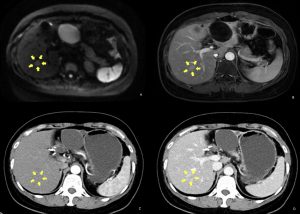Mrs. H, a 55-year-old woman, had a radical lobectomy seven months ago after being diagnosed with microinvasive lung cancer. She has been undergoing follow-up exams every three months to check for any evidence of recurrence or metastases. During the most recent chest CT, her doctor noticed a hypo-density mass in her right liver. This finding was indeterminate in the current study. Considering Mrs. H’s known lung cancer history, doctors were concerned that the liver mass may indicate the presence of metastatic disease. Further evaluation with abdominal exams was recommended.
Doctors there performed contrast-enhanced liver CT and MRI. The MRI images showed an approximately 1.5cm-sized lesion with restricted diffusion and sustained enhancement in segment 6 of the liver (Fig. 1A, 1B). The CT scan showed a suspicious nodule with inhomogeneous mild enhancement (Fig. 1C, 1D). Given these findings, the patient’s liver mass was considered as liver metastasis. Then she was hospitalized for further treatment.

To further characterize the liver mass, a contrast-enhanced ultrasound (CEUS) examination was obtained. CEUS demonstrated iso-enhancement of the lesion on all contrast phases (Fig. 2) compared to surrounding parenchyma. This kind of contrast enhancement pattern was typical for a benign portion of heterogeneous fatty liver.

In the end, a liver biopsy was carried out to confirm. The histologic evaluation revealed modest fatty infiltration along with localized hepatocellular hyperplasia. No tumor cells were discovered when combined with the immunohistochemical staining data. This ruled out the more concerning diagnosis of metastasis and supported the diagnosis of heterogeneous fatty liver.
Thanks to the CEUS exam, Mrs. H will be able to avoid unnecessary operations and receive better care. She is still being followed with abdominal US and chest CT. However, there is no need to concern about liver metastasis given the CEUS results and the biopsy’s demonstrated absence of tumor cells.







